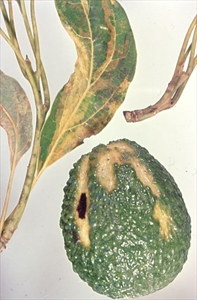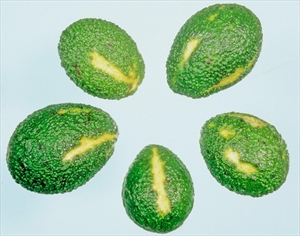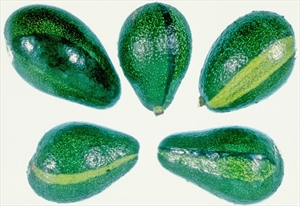Avocado sunblotch
Pacific Pests, Pathogens and Weeds - Online edition
Pacific Pests, Pathogens & Weeds
Avocado sunblotch (368)
Avocado sunblotch viroid. The abbreviation is ASBVd.
Asia, Africa, North, Central and South America, Caribbean, Europe, Oceania. Present in Australia, but not recorded in Pacific island countries.
Avocado and some other members of the Lauraceae family.
The viroid causes sunken, yellow, irregular streaks on the leaves, stems and fruit (Photos 1&2). Vein-yellowing may also occur on the leaves. However, the appearance of leaf symptoms is uncommon and erratic, and the depressed streaks that occur on the young stems are a more reliable symptom of the disease. Typically, rectangular cracking occurs on the bark of older branches and trunks (called alligator bark). Symptoms on the fruit are similar to sunburn, hence the name 'sunblotch' of this disease. They should not be confused with streaks of yellow and other colours that are due to genetic causes (Photo 3).
Symptoms depend on the avocado variety, the environment and the viroid strain. Often, trees show no symptoms (symptomless carriers). The seed from these trees may be 100% infected, but the seedlings used as rootstocks may not show symptoms. Symptoms may develop, however, when scions are grafted on them.
Symptomless carriers have a high concentration of the viroid and spread the disease rapidly. By contrast, trees with symptoms may not produce infected seed, and likewise budwood and shoot cuttings from these trees may not contain viroid. Nevertheless, whether with symptoms or not, trees infected with avocado viroid show large yield reductions.
Spread occurs in a number of ways. It can occur by root to root grafts that occur naturally in orchards, and it can also occur via infected budwood or rootstocks, on pruning tools, pollen, and via seed.
A serious disease causing up to 95% loss of yield in some varieties (e.g., symptomless Caliente and Reed). Hass, a popular variety worldwide, is also susceptible. Observations reported from Mexico are typical with 75% and 52% reduction in weight of fruit in trees of two orchards with symptoms, and 30% reduction on trees without symptoms. Yield reductions of another variety, Mendez, were even greater.
Look for early symptoms, which appear as narrow, white, yellow or pink streaks on the surface of young stems. Look for sunken, white, yellow or pink blotches or streaks on small deformed fruit. PCR is used to detect infection, and there are biological indexing protocols, which generally require long incubation times.
CULTURAL CONTROL
It is important to carefully monitor nurseries and plantations; especially ensure that nursery stock is free from the disease. By doing so, avocado sunblotch will be reduced to a minor disease.
Before planting (in the nursery):
- Use root stocks and scions from registered sources, certified free of sunblotch viroid.
- Disinfect tools used for pruning by scrubbing and then soak them in household bleach (1 part commercial-strength bleach to 4 parts water).
During growth (in the plantation):
- Monitor the trees. Look for discolored leaves, young stems and deformed, streaked or discoloured fruit, rectangular bark cracking (alligator bark), and stunted tree growth. If symptoms occur, remove the tree (killing the stump with herbicide), and consult with agriculture authorities about testing the remainder. Note that symptomless trees may be an important source of the viroid, and rapidly infect others causing substantial yield decline.
- Disinfect tools used for pruning by scrubbing and then soak them in household bleach (1 part commercial-strength bleach to 4 parts water). Clean the tools between each tree.
-
Note that pruning mature trees to reduce height may stimulate the virus to become active in new growth.
CHEMICAL CONTROL
Chemical control is not appropriate for this disease.
AUTHOR Grahame Jackson
Information from CABI (2018) Avocado sunblotch viroid (avocado sun blotch). Crop Protection Compendium. (https://www.cabi.org/cpc/datasheet/8083); and Avocado sunblotch (2016) University of California Agriculture and Natural Resources, Statewide Integrated Pest Management Program. (http://ipm.ucanr.edu/PMG/r8101011.html); and from Saucedo-Carabez JR et al. (2014) Effect of Avocado sunblotch viroid (ASBVd) on avocado yield in Michoacan, Mexico. European Journal of Plant Pathology 138(4):799-805. (https://link.springer.com/article/10.1007/s10658-013-0354-9). Photos 1-3 Diseases of fruit crops in Australia (2009). Editors, Tony Cooke, et al. CSIRO Publishing.
Produced with support from the Australian Centre for International Agricultural Research under project HORT/2016/185: Responding to emerging pest and disease threats to horticulture in the Pacific islands, implemented by the University of Queensland and the Secretariat of the Pacific Community.






